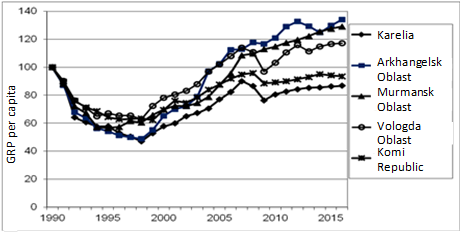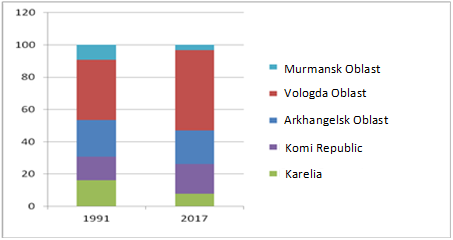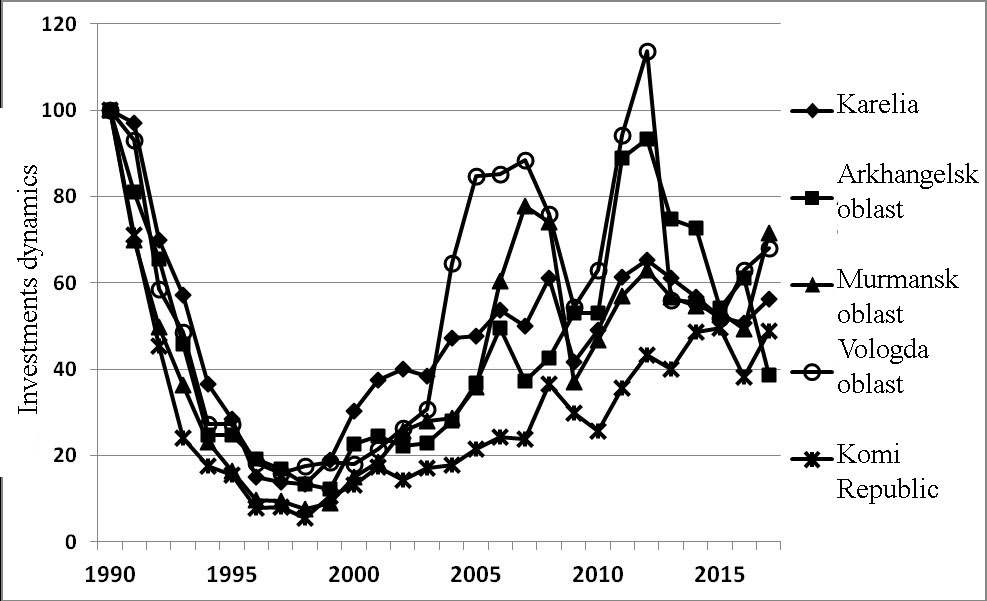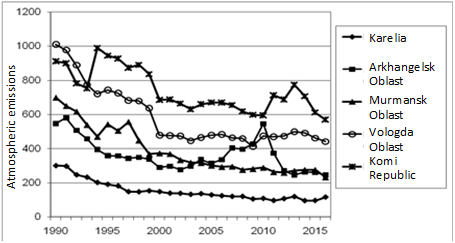Abstract
The article shows research results that addressed issues on ecological and economic development of Russian regions in the European North, which include Karelia and Komi, Arkhangelsk, Vologda and Murmansk regions, introducing the North-Western Federal District territory. The study is based on methods used in statistics analysis and on the principles applied in designing ecological-economic models. The analysis describing the dynamics in the main economic indicators and its graphical models are presented. A comparative analysis has been carried out and some features of the Northern regions development have been highlighted. The attractiveness to make investment to the Northern territories is related to natural resources availability, including hydrocarbons. The influence coming from external shocks associated with the Federal economic policy is shown. The analysis of the dynamics observed in main ecological indicators shows a gradual decrease in the negative impact on the environment. Differences of Northern regions and peculiarities of ecological and economic processes happening there are revealed. Compiling a model depicting multiplicative functions of pollution, we identified the influence of economic development on the economic situation in territories of regions and the European North as a whole. Based on calculations to have been carried out, the effect of economic recession and growth, structural changes and modernization in the economy is shown. Prospects for the ecological and economic development of Russian regions of European North are determined. They are mostly related to the diversification of the economy, technological expansion towards natural resources processing and using the best available technologies in production.
Keywords: Gross regional productinvestmentstructural changesenvironmental pollutionindustryagriculture
Introduction
In modern conditions in the northern territories of Russia there has developed a rather complex socio-ecological-economic situation, which is caused by the economic development of the country. As a result of the transformation happening in economic relations in Russia in the early 90s of the 20th century, a decline in the Russian economy occurs, accompanied by a change in its structure. In the structure of gross national product, there is an increase in the service sector development and a decrease in manufacturing and agriculture. In the late 90s, as the national economy grew, the transformation of its structure was accompanied by an increase in services and by a decline in agriculture. In addition, a decline in trading and a slight increase in manufacturing industries are observed. After the financial crisis of 2008, the share of trade in the structure of the Russian economy significantly decreases and the share of agriculture stabilizes. The transformation in the economy structure of the Russian regions occurs under the influence of the Russian economic policy (Kuznetsov & Ivanov, 2015).
In the 90s there was a decline in socio-economic development in almost all regions of our country. In the Northern regions, there were more significant disparities in socio-economic development. The Russian regions of the European North had their own characteristics, related primarily to the harsh climatic conditions of residence and the peripheral position of the territories. One of the factors determining the successful development of the countries of Western Europe is favorable climatic conditions. Given the climate warming, it was expected that a similar effect will emerge in the Northern regions. But in harsh conditions, the negative manifestation of this factor associated with permafrost violation is more significant, which leads to the gradual destruction of the production infrastructure, various buildings and dwellings (Granberg, 2002).
In the twentieth century, in the northern territories of our country, the extraction and primary processing of natural resources actively developed. In the early 1990s, in the context of liberalization of foreign economic activity, many enterprises in the extractive industries were able to independently provide trading with foreign countries and redirect their production to the external market. The loss of a significant part of the Russian market was strongly reflected in the processing enterprises, but overall, the decline in the economy of the Northern regions was close to the average rates in the Russian Federation (Kuznetsov, & Ivanov, 2015; Granberg, 2002). The economic downturn in the Northern regions was accompanied by an outflow of the population, with the population leaving the northern territories more actively. At the same time, the population as a whole has stabilized.
The economic growth of the late 1990s manifested itself in all the Northern regions, but the growth rates in these regions were lower than the average Russian ones. This situation is accounted for the presence of limited opportunities for increasing production rates of enterprises of the extractive industries, which shape the basis of the economy of the Northern regions. At the same time, high hydrocarbon prices contributed to the start of major projects on the shelf. The fall in prices has hindered their development, and all research the Arctic regions have slowed down. Nevertheless, the Northern regions with significant natural resources have good prospects to develop further (Tatarkin & Loginov, 2002). But the further socio-economic development of the Northern regions is mainly associated with the development of natural resources. Unfortunately, the transformation in the economy structure ongoing due to the development in education and digitalization of the economy, as it is happening in Northern European countries, is not yet considered as a strategic paradigm.
Over the past quarter century, the economy structure of the Russian regions of the European North has changed significantly (Melitz, 2007). The impact on the environment has also changed, greening processes are observed due to the closure of many enterprises, to the modernization of existing industries and to an increase in the areas of specially protected natural territories (Lavopa & Szirmai, 2018).
Problem Statement
In the modern conditions the disproportions in social and economic development of the Northern regions of the European part of Russia are acutely emerged. At the same time, the growth rates of the Northern regions lag behind the national average ones within the most social and economic indicators. The main reason for the low level of development observed in the northern territories is the influence coming from external shocks caused by federal economic policies, as a result of which these territories have less competitive advantages compared to other regions of the Russian Federation.
Research Questions
The article discusses the ecological and economic development of 5 Russian regions (Murmansk, Arkhangelsk, Vologda Oblasts, the Republic of Karelia and Komi), which have harsh climatic conditions and belong to the European North during the transformation period in the Russian economic system that has been happening since the early 90s of the 20th century.
Comparative analysis of the changes that have occurred in these regions has been carried out, the existing interrelations of indicators have been scrutinized, multiplicative models of interrelations of economic and environmental indicators of the development in these territories have been constructed. The Russian regions of the European North are bordered by Finland and 9 regions of the Russian Federation. Most of the territory is located at the watershed of the White Sea, the north-western and eastern parts - the Barents and Kara seas, the south-western one - the Baltic and Caspian seas.
Purpose of the Study
Based on the analysis conducted to identify the dynamics of the main environmental and economic indicators and their interrelations, we state the goal to determine the differences between the regions belonging territorially to the European North and their peculiarities in the ecological-economic processes, and to outline the prospects for socio-ecological-economic development.
Research Methods
Statistical information is available on the websites of FSSS (Federal State Statistics Service) and its regional institutions, as well as in the proceedings published by FSSS “Russian Regions” and in the materials/brochures of its regional offices. In order to make the calculations, we used the following indicators - gross regional product (GRP), the ratio in industrial production dynamics, indices in agricultural production, rates in investment, number of inhabitants, emissions of pollutants into the atmosphere, figures in fresh water intake and in wastewater discharges.
Data collected from various sources were thoroughly verified and, if needed, corrected. With the aim to characterize the region and to build up graphs for the main indicators describing the cost-related criteria, we transferred them through recalculation into comparable-base prices, be precise through the price index. When constructing transitional graphs, the data were adopted to the common methodology. Due to transition from industries to activities, the data within the period of 1990-2004 were recalculated based on the information available in various sources. The final indicator was constructed in percentage towards the starting year, the data were taken as 100% (in some cases, the data of 2015 were taken as 100%). On the FSSS website, comparable series are given in prices of 2008, 2011 and 2016.
Methods applied in analyzing statistical data, comparing and grouping, conducting structural and regression analysis were used in the study. When analyzing the data on the economy of the European North as a whole and for individual regions, the derived indicators were determined, inter alia their growths and growth rates; their graphs were constructed and analyzed. Then, using graphs-based on indicators, their possible interrelations fell under analysis. As a result, some hypotheses were assumed reflecting dependencies and possible dynamics in parameters. Analysis of graphs by periods allowed us to formulate the hypothesis about changing tendencies (Druzhinin, 2013).
The pollution functions can be based on private or complex environmental indicators; various functions are used for calculations, for example, multiplicative:
where: Z (t) is the environmental indicator under study (absolute value, or annual increase); U1 (t) - a factor reflecting the development of the economy and, as a rule, negatively affecting the environment (GDP, GRP, investment in the economy, etc.); U2 (t) is a factor reflecting environmental activities and positively affecting the environment (investments in environmental protection, etc.); A (t) is a factor reflecting the influence of structural changes (estimated through an exponent or through a change in the structure of sectors); t is the year; m, h - constants (factorial elasticities). The standard statistical software were used to process the data (Druzhinin & Shkiperova, 2012).
Findings
The economic development of the regions in the European North is characterized by a slower pace. As a result, the development dynamics of these territories differs from the development dynamics of the Russian regions. However, among this small group of regions there is heterogeneity in the development of territories. As a result, some territories are developing more successfully, using their competitive advantages, the others - vice versa. The analysis of the main economic indicator of GRP allowed considering the territories through the dynamics in development comparing it with the initial level, recorded in 1990. The study resulted in revealing the fact that by early 2014 the regions of the Arkhangelsk and Vologda regions in terms of the development covering production potential reached the level of 1990. The GRP of other regions has lower rates in the economic growth. Thus, the GRP of the Republic of Karelia and the Republic of Komi is 2/3 of the 1990 level.
The growth rates of the Russian regions are characterized by the growing tendency. With a low growth rate of the Northern regions, their backlog becomes more significant. However, if we consider the GRP per capita, then, in the period since 1990 till 2008, the gap between the regions is not very significant (Figure

A possible reason affected the heterogeneous development in the Northern regions can be the location of plants dealing with processing natural resources (Moroshkina, 2016). In south of the European North, there is a dense concentration of plants who work with processing natural resources; the regional ‘natural resource’ capitals are located in Petrozavodsk, Vologda and Syktyvkar; large cities are Sokol, Velsk, Kotlas, Koryazhma, Velikiy Ustyug. As a result of identifying the features of the studied regions, the economic characteristics of the territory were determined, which show a high level of growth. These territories in Khibiny, where various minerals are mined and their primary processing takes place, are: Kirovsk, Apatity, Monchegorsk, Olenegorsk. Part of the analyzed territories are large industrial and engineering centers (Arkhangelsk, Severodvinsk, Novodvinsk).
Two more populated territories in Khibiny (Kirovsk, Apatity, Monchegorsk, Olenegorsk) where various natural resources are mined and then processed. In the mouth of the Northern Dvina where large industrial centers are located, mechanical engineering sectors and paper production are developed (Arkhangelsk, Severodvinsk, Novodvinsk). The rest of the territory is occupied with relatively big cities - Kostomuksha and Segezha in Karelia, Murmansk, Pechenga and Kandalaksha in the Murmansk region, Onega, Plesetsk and Nyandom in the Arkhangelsk region.
The study resulted in revealing the connection between the geographical position (latitude) and the structure of the economy, which varies from northern to southern territories. In the European part, the economy of the northern countries is highly efficient; labor productivity is much higher than the southern countries have. The north of Europe is characterized with a higher share of extractive industries and low-resource-intensive sectors of the economy, above all information technology (IT). For the Russian Federation, the dependence identified above is not confirmed, such connection is not present (Druzhinin, 2013). In the regional context, Karelia and the Vologda Oblast are characterized by exceeding the average values in the Russian Federation. In general, the level of innovation activity in the Northern regions of Russia is low (Nemkovich & Kurilo, 2012).
Another indicator, which we uses in analyzing the Northern territories, is agriculture. This is in slow development in the regions that we discuss. There is a tendency: the more to the North the territory, the smaller the share of agriculture in GRP (Druzhinin, 2013). However, recently the influence of warming has become more pronounced. The assumption made for 4 regions (areas of the Murmansk region, where the share of agriculture is insignificant, were not under consideration) has been confirmed and proved that a relative growth in temperature regime impacts positively agricultural production index. The reduction is observed in all agricultural spheres. The period until the end of the 1990s was characterized by an increase in agricultural production, and Komi kept up this tendency till today. In other regions, agricultural production is again slowly declining.
Considering agricultural production geography, we can conclude that it is mostly concentrated in the Southern regions. A significant part of it, almost half, is in the Vologda region (Figure

The important indicator in successful economic development is investments. The behavior of this indicator within considering period is characterized with uneven tendencies. During the 1990s, the decline in investments contributed to the economy of the European North was clearly observed (Nemkovich & Kurilo, 2012).
The decline in dynamics was significantly longer than the corresponding stint in the Russian Federation. Economic stability periods in the Russian economy: 1998-2001, 2004-2006 and 2011-2012. They are characterized by more intensive investments in the Northern regions. The dynamics in investment to the Northern regions in these periods was higher than to the Russian economy. The investment flows dynamics in the regions under consideration coincides and the evidence in figures – there is a decline in the 1990s by 5-10 times. In future, the growth of investment is interrupted by the economic crises of 2008–2009 and 2013-2015, which affect the number of investment flows to the regions. The tendencies in development of the regions coincide; all the studied regions in the period from 1990 to 2000 were experiencing a decline in investment in the capital assets. Since the mid-2000s, the amount of investment has decreased by half as compared with the 1990s. In some periods the Northern regions with a developed production potential - the Arkhangelsk, Murmansk and Vologda regions - almost reached the pre-reform level. In recent years, practically all regions, the growth has been replaced by the recession (Figure

The geography of investment attractiveness depends on natural resources availability. This means that the Northern regions are becoming automatically more attractive in terms of investments.
The growth in investments is observed in the Arkhangelsk Region and the Komi Republic that corresponds totally with assumption about the influence of the resources potentila. Within these regions, the statistics is as follows: in the 1990s the volume of investment to the territories under discussion accounted to about half the total investment. Now this figure has increased and is determined by more than 60%. In terms of investment per capita, the Komi Republic occupies the 7th place in Russia but Karelia is on 57th place.
Northern nature has a vulnerable structure, which is slowly recovering from human intervention. This requires high costs in terms of organizing and maintaining environmental protection measures. During the 1990s, when economic situation was in its decline, the ecological situation noticeably improved. During the economic growth, the environmental impact increases, for example, over the past ten years emissions to the atmosphere emanating from stationary sources have decreased by only 15%; discharges of polluted waste water have decreased a little more - by 22%.

The emissions of pollutants into atmosphere have decreased in all 5 regions (Figure
Our calculations have shown that it is possible to depict dependencies over the period considered by using the previously introduced concept of neutral ecological progress that is associated with structural changes (Uy, Yi, & Zhang, 2013). In addition, the calculations were carried out for two separate periods: 1990-1998 and 1999-2016. In terms of the emissions into the atmosphere we found that 1% -increase in GRP leads to the increase in emissions rise in average by 0.26%, while due to structural changes and manufacture modernization the emissions have been reduced annually by 2.8%.
Conclusion
To improve the socio-economic situation prevailing in the Russian regions of the European North, the strategic state policy is needed to rule and control development towards the economy diversification with the focus on resources processing, re-optimization the existing structures involved into resources processing and availability of cutting edge technologies (Mele & Stefanski, 2019). The Northern regions are developing more slowly than the Russian Federation as a whole. They had a stronger downturn when the reforms started, and a slower growth afterwards in the 2000s. Only the beginning of the new deposits development, mainly on the shelf, led to a sharp increase in economic indicators. At existing enterprises to increase the extraction of raw materials is very difficult. Most of the processing-based enterprises turned out to be uncompetitive because the production in the Southern regions is cheaper. Accordingly, the population is rapidly decreasing. Extraction and primary processing of raw materials remained in the regions located closer to the north. Since, more advanced industrial processing, primarily metallurgy and paper production, is concentrated in the more southerly located regions of the European North, the population decline there is noticeably lower (Savonaa & Ciarlib, 2019).
The peripheral position of the European North leads to a situation when the hope to recovery industries based on natural resources processing are becoming vague and non-realistic. Instead, servicing sector has more chances to develop successfully. In the 1990s, the recession was accompanied by a decrease in environmental impact. The growth of the economy in the 2000s was due to the modernization and launching new industries based on new technological approaches that allowed hindering the rise in environmental pollution. Reduction towards the burden on the environment creates an opportunity for more active development of tourism sector, because the beauty of the northern nature has always attracted travelers that might entail additional investments able to affect significantly the situation as a whole. Thus, in 2017, the newly created mountain park Ruskeala was visited by more than 300 thousand people.
The situation at our northern neighbors is not so sad. For instance, in Finland the population who reside in the north of the country, thus, in Oulu the population have grown by one and a half times within 1990-2016. Non-material-intensive sectors based on intellectual property are developing successfully in the North, especially, this relates mostly to projects in IT sphere. The success of Finland was associated with resoanable government policies - increasing support for existing universities and creating new ones, such as the University of Eastern Finland in Joensuu (city with population of 50,000 residents) that is ranked constantly in the top 500 of the World University Ranking. Following the example of our neighbors we can conclude that the sustainable support provided from the Government to the northern Russian universities and research centers, with orientation them towards developing economic sectors is able to stabilize the situation in the European North (Lavopa & Szirmai, 2018).
Acknowledgments
The research is carried out with the financial support from the Russian Funds for Basic Research in the framework of the research project No. 18-05-60296 “The fundamental problem of the natural and social environment of the White Sea and the catchment area: the state and possible change under different scenarios of climate change and economy”.
References
- Druzhinin, P. V. (2013). Assessment of the Relationship between Economic Growth and Political Institution in a Region. Regional Research of Russia, 3(2), 162–167.
- Druzhinin, P. V., & Shkiperova, G.T. (2012). Ecological and Economic Models and Prediction in the Regional Management System. Studies on Russian Economic Development, 23(1), 66–72.
- Granberg, A. G. (2002). Macroeconomics of the European North of Russia. The Economy of the North-West: Development Problems and Prospects, 4, 3–10.
- Kuznetsov, S. V., & Ivanov, S. A. (2015). National Priorities in the Economic and Social Strategy of the Macroregion "North-West". Economics and Management, 11, 22–29.
- Lavopa, A., & Szirmai, A. (2018). Structural Modernization and Development Traps. An empirical approach. World Development, 112, 59–73. Retrieved from:
- Mele, A., & Stefanski, R. (2019). Velocity in the Long Run: money and structural transformation. Review of Economic Dynamics, 31, 393–410. https://doi.org/10.1016/ j.red.2018.09.004
- Melitz, J. (2007). North, South and Distance in the Gravity Model. European Economic Review, 51(4), 971–991.
- Moroshkina, M. V. (2016). Differentiation of Russian Regions in Terms of Economic Development Level. Problems of forecasting, 4(157), 109–115.
- Nemkovich, E. G., & Kurilo, A. E. (2012). Economical Geographical Position of Karelia. Gornyi Journal, 5, 5–7.
- Savonaa, M., & Ciarlib, T. (2019). Structural Changes and Sustainability. A Selected Review of the Empirical Evidence. Ecological Economics, 159, 244–260.
- Tatarkin, A. I., & Loginov, V. G. (2002). Assessment of the Natural Resource and Production Potential of the Northern and Arctic Regions: current state and prospects in using forecasting methods, 1, 33–44.
- Uy, T., Yi, K. M., & Zhang, J. (2013). Structural Change in an Open Economy. Journal of Monetary Economics, 6, 667–682. DOI:
Copyright information

This work is licensed under a Creative Commons Attribution-NonCommercial-NoDerivatives 4.0 International License.
About this article
Publication Date
28 December 2019
Article Doi
eBook ISBN
978-1-80296-075-4
Publisher
Future Academy
Volume
76
Print ISBN (optional)
-
Edition Number
1st Edition
Pages
1-3763
Subjects
Sociolinguistics, linguistics, semantics, discourse analysis, science, technology, society
Cite this article as:
Kurilo, A., Moroshkina, M., & Druzhinin*, P. (2019). Economy Development Of European North And Its Influence On Environment. In D. Karim-Sultanovich Bataev, S. Aidievich Gapurov, A. Dogievich Osmaev, V. Khumaidovich Akaev, L. Musaevna Idigova, M. Rukmanovich Ovhadov, A. Ruslanovich Salgiriev, & M. Muslamovna Betilmerzaeva (Eds.), Social and Cultural Transformations in the Context of Modern Globalism, vol 76. European Proceedings of Social and Behavioural Sciences (pp. 300-309). Future Academy. https://doi.org/10.15405/epsbs.2019.12.04.42
